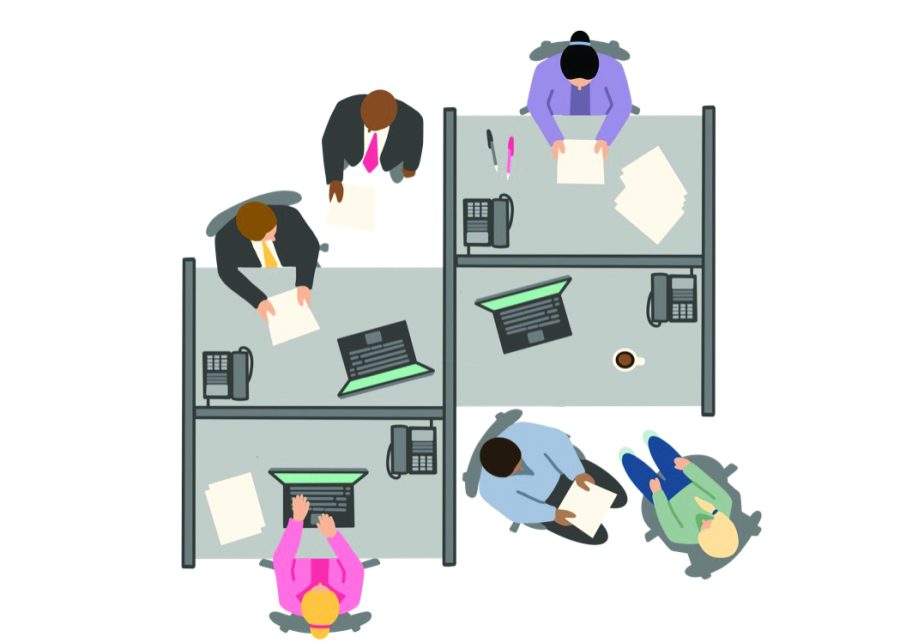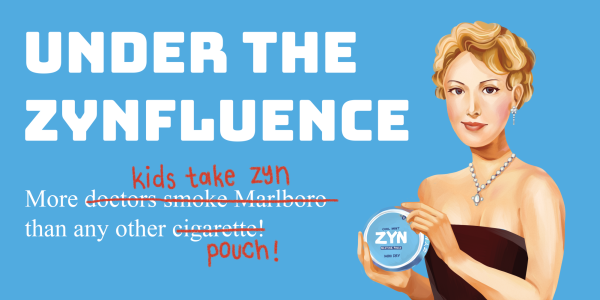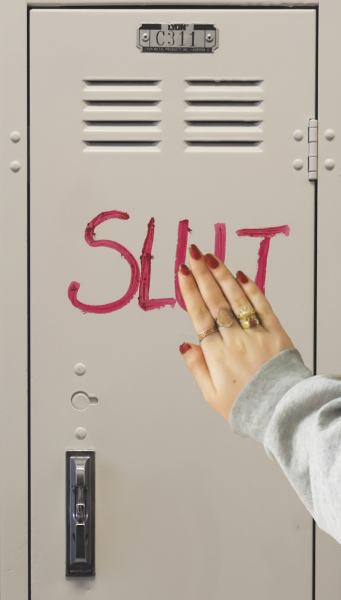Beyond the Gradebook
An illustration depicts teachers seated in their office cubicles doing work.
September 28, 2022
As Chris Weng ’24 sat at his desk, Zooming into his English class during quarantine, he was stunned: rather than discussing the assigned reading, his teacher had suddenly begun a rant about her personal life. Weng said it made him feel uncomfortable and created an unworkable class environment.
“It made a lot of kids in the class, myself included, feel like we were ostracized,” Weng said. “We couldn’t open our mouths; we couldn’t say anything, because the views just seemed so extreme.”
Weng said that after the rant, he suspected his teacher was experiencing poor mental health due to personal issues, and he and his classmates were experiencing the consequences of his teacher’s frustration.
“With the teacher having to deal with [personal problems], the kids will have to deal with them [too],” Weng said. “There might be some minor or even major inconveniences throughout the year. It was understandable, but objectively if you look at how it affects kids and the class, obviously [the class will] be a worse experience.”
A recent survey by Rand Corporation about occupational stress revealed that 78% of teachers experience frequent job-related stress in comparison with 40% of employed adults. Later, the survey also disclosed that one in four teachers experience symptoms of depression.
Teachers reflect on their professional life and its effect on their personal affairs
Science Teacher Richard Vo said he often feels overwhelmed by his workload, which he said he feels is comparable to that of his students.
“There’s just a lot of demands on our time,” Vo said. “Student meetings, parent meetings, and comments are big things. I think [something] that contributes to stress is being overloaded with work, which I think is true of students as well.”
During college application season, Vo said many teachers experience heightened stress while writing college recommendation letters on their students’ behalf.
“Depending on how many juniors [a teacher] has, some teachers have 30 letters of rec to write,” Vo said. “I don’t have that many, but I think I have five this year.”
Though pressures like recommendation requests are constant, Vo said the stress he felt peaked during the pandemic, when the social connection between teachers and students was hindered by online learning.
“I am the type of person that really benefits from student-teacher interaction, I really like it when I make a joke and hear students laugh,” Vo said. “When everyone’s muted and half the class doesn’t have their camera on, it’s just super awkward [to teach]. I paid a huge mental toll there. That was really bad. I wasn’t motivated to do work. I wasn’t motivated to think about lessons because I was just kind of depressed about that, which all piled up and made me more depressed.”
Vo said these feelings conflict with the duty he feels to act as a role model and support system for his students, a position that itself produces stress.
“I think all adults, when they’re working with kids, have a responsibility to be a stable rock that [students] can vent to, so that you can give life advice,” Vo said. “But that takes a toll on you, because you’re thinking about ‘what could you do better?’ ‘Is there something better than you could have done or better advice that you could have given?’ You’re constantly worried about their well-being.”
In his first year at the school, Vo said he felt pressured to be present in all aspects of the community and had a hard time balancing his personal life.
“But after that first year, my husband sat me down and said, “‘I never see you anymore,’” Vo said. “‘This is not sustainable.’ He’s right; I wasn’t spending any time with him. I would do all these extracurricular things that were putting demands on my time. It was actually a vicious cycle of just constantly being in work mode. My husband wasn’t getting what he needed. I wasn’t getting what I needed.”
Like Vo, History Teacher Lilas Lane also said she struggles with balancing her personal and professional lives but sets boundaries to prevent work from infringing significantly on her daily affairs.
“I’ve been here for 10 years, and I’m still working on how I prioritize some downtime, some time with family, or some time to exercise,” Lane said. “I think I have gotten better as time goes on, as [my] systems of feedback start to get better. [I] have to be disciplined in the same way that students have to be and work from this time to this time and be productive, but then take a break.”
Lane said after her mother’s death, her relationships with her co-workers provided a support network and a friendly environment that reduced her stress.
“When my mom died, I took the first week away, and I came back after that,” Lane said. “My department chair [said I could] take longer if I need to. I felt supported in that way, and my colleagues at the middle school sent me all this GrubHub money. That kind of support was really nice, with people reaching out. I think it is really important to have good relationships with your colleagues.”
Lane said her connections with her students are crucial aspects of her teaching and well-being.
“The key for my mental and emotional well-being is to have that endgame where kids have broken through to another level [of learning],” Lane said. “I helped them do that as their brains are developing. That’s a very gratifying thing.”
Although student relationships are extremely rewarding, Lane said she hopes the school will prioritize managing small class sizes, typical of private schools to promote intimacy in the classroom.
“[The history department] hired a new person, so that we could all have classes of 16 [students],” said Lane.“All of my classes are over, and it makes a difference in the way that I can teach. It’s hours and hours more work for me because I need time to meet with students and time to grade their work. All of that is something that takes time, so every time I add a student on, that is hours and hours more work. This is an issue. We’re supposed to have a limit of 16 per class, but that doesn’t really happen.”
Public school teacher discusses possible stressors at school
Public elementary school teacher Lillian Delgadillo said big class sizes can be draining for her.
“Having a class of 24 plus students in the classroom is difficult to handle,” Delgadillo said. “Classroom management is very difficult as it is, before when I was in the classroom, I’ve actually ended the day crying because it is very exhausting.”
Delgadillo said she does not feel recognized for her work as a resource teacher in the Los Angeles Unified School District due to its lack of community.
“I don’t feel [appreciated],” Delgadillo said. “It might be different for other teachers because they’re in the classroom. I’m a teacher that travels to different schools, so I’m not part of that actual school community, which makes it harder for teachers to make a connection with me, because they say, ‘resource teachers are there for a year, and then they leave, so they don’t care,’ which is not true. It can be really hard. I wanted to feel like I was appreciated because of the work that seemed insurmountable.”
Delgadillo, who is on maternity leave with her second child, said she wouldn’t have time for both her work and childcare when she goes back to work.
“It’s hard right now when I’m not working, so you can imagine when I actually have that added stressor,” Delgadillo said. “You have to find time for everything, and sometimes there aren’t enough hours in the day. I think there’s a daycare for parents that are teachers, but I don’t think I’m qualified.”
Delgadillo said she has trouble balancing her outside of class demands from school and her family life.
“I’ve had so many fights with my partner because of all the work I take home,” Delgadillo said. “It’s impossible because I have my biological children, but I also have my children at school, which are also like my kids. I can’t leave one for the other. I feel like I am responsible for both, and it can be a problem at home. That’s not part of the nine-to-five job.”
Teachers consider the school’s environment and resources
Although there are school resources, Symphony and AP Music Theory Teacher Hilt said he feels stressed when doing prep work between lessons but enjoys teaching.
“The environment [when symphony is] playing a piece is terrific,” Hilt said. “Running a rehearsal and playing music is the easiest thing. For me, the library tasks, like making sure [students] have the right music, finding lost copies and being the bookkeeper for the coaches are tricky. That takes some time outside of class, but once you’re in class, it’s really great.”
Hilt said he feels supported in the school’s community.
“There are a lot of people I could talk to,” Hilt said. “I know there are places online on the faculty staff page where I could find people. Dr. [Sophie] Wasson is a good friend of mine, so I could talk to her. She’d point me in the right direction or would just be a good listener.”
Like Hilt, Lane said though she feels supported by the community, she emphasizes the importance of her current friendships and wants to build new ones.
“I’ve been thinking about that a lot this year and wanting to branch out more and more friends,” Lane said. “When you hit my age are sort of like, you’re not necessarily giving the relationship, the time and attention. You should like to maintain good friendships. I’m trying to be open to new friendships and taking the time to care for the relationships that I have and value.”










































